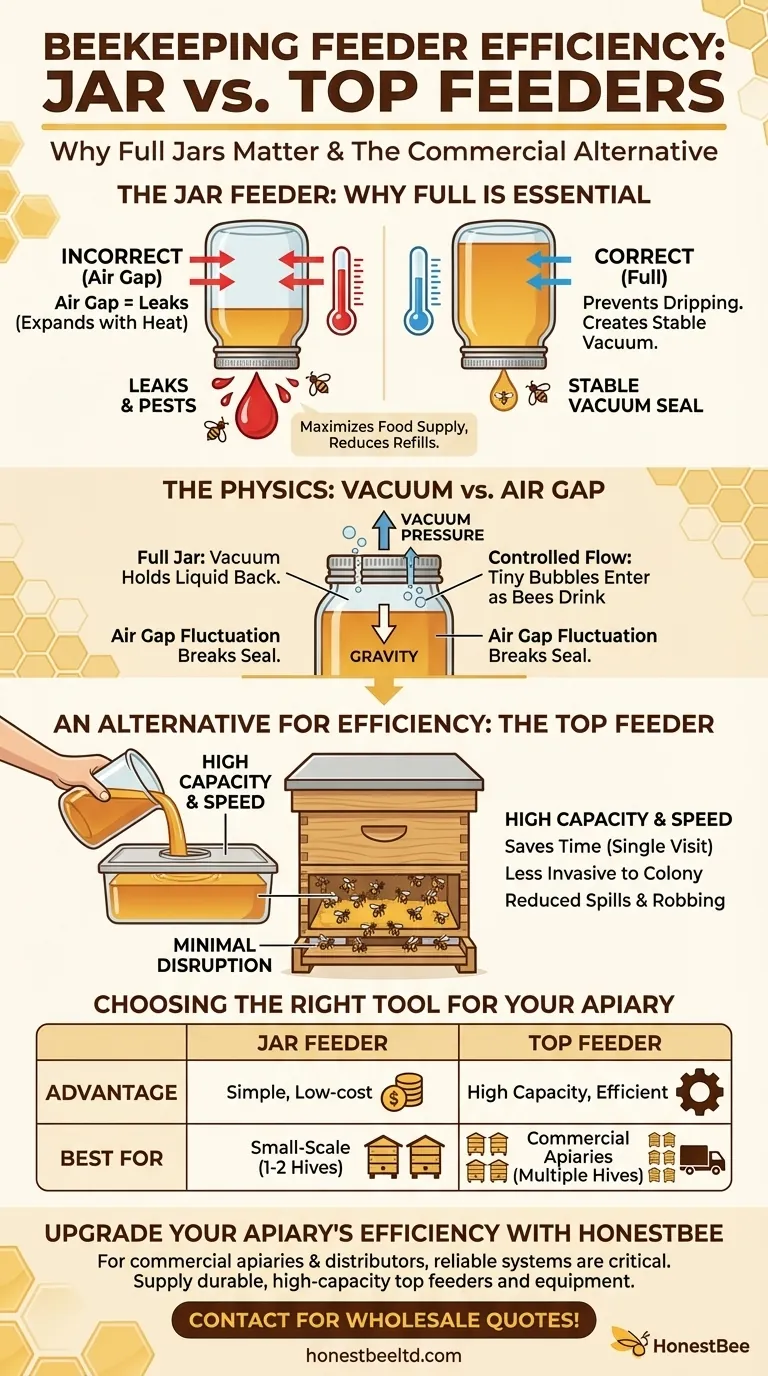To prevent dripping, filling a jar feeder completely to the top is essential. This action creates a stable vacuum seal when the jar is inverted, which holds the sugar syrup in place. Any significant air gap at the top will allow air to expand and contract with temperature changes, breaking the vacuum and causing the syrup to leak out, creating a mess and attracting pests.
The core issue isn't just about filling a feeder; it's about providing food efficiently and cleanly. While correctly filling a jar feeder solves the immediate problem of leaks, understanding different feeder types, like top feeders, addresses the deeper need for a truly robust and minimally disruptive feeding strategy.

The Physics of a Jar Feeder
To use a jar feeder effectively, it helps to understand the simple physics that make it work. The entire design relies on maintaining a delicate pressure balance.
How a Vacuum Prevents Leaks
A completely full jar, when inverted, creates a vacuum at the top. This vacuum pressure is what holds the liquid back, preventing it from rushing out of the small holes in the lid.
The bees can then drink the syrup, and as they do, tiny air bubbles enter to replace the liquid, keeping the pressure equalized and the flow controlled.
The Problem with an Air Gap
If you leave a large air gap in the jar, that trapped air will expand when it gets warm and contract when it cools.
This fluctuation in pressure is enough to break the vacuum seal, forcing syrup out of the holes and causing significant dripping. This not only wastes food but can also encourage robbing by other bees.
Maximizing the Food Supply
A secondary, more obvious benefit of filling the jar to the top is that it provides the maximum amount of food to the colony. This reduces the frequency of your visits to the apiary to refill the feeders.
An Alternative for Efficiency: The Top Feeder
While jar feeders are common, their limitations have led to other designs. For beekeepers managing multiple hives or distant apiaries, the top feeder often presents a more practical solution.
Designed for High Capacity and Speed
Top feeders are essentially large reservoirs that sit on top of the hive. Their high capacity means you can provide a large volume of syrup in a single visit, saving significant time.
The wide-open shape also makes them much faster and simpler to fill than multiple small jars, drastically reducing the chance of spills.
Minimizing Colony Disruption
Refilling a top feeder is far less invasive. You typically only need to remove the outer and inner covers to pour in more syrup. The bees in the brood boxes below remain largely undisturbed.
Reducing Spills and Robbing
Because they are a more contained system, top feeders are less prone to the leaks caused by faulty seals or temperature changes that can plague jar feeders. This clean operation helps deter robbing from other colonies.
Understanding the Trade-offs
No single solution is perfect for every situation. Choosing the right feeder depends on understanding the inherent compromises of each design.
Jar Feeder Limitations
The primary drawbacks of jar feeders are their small capacity, requiring frequent refilling, and their sensitivity to temperature changes if not filled correctly. A faulty seal on the lid can also lead to a complete and rapid draining of the jar.
Top Feeder Considerations
While highly efficient, top feeders are bulkier and have a higher initial cost. They also add height to the hive, which can be a factor depending on your setup. They are best suited for beekeepers who prioritize time-savings and capacity.
Making the Right Choice for Your Goal
Your choice of feeder should align directly with the needs of your apiary and your management style.
- If your primary focus is simplicity for one or two hives: Jar feeders are an inexpensive and effective option, provided you always fill them completely to the top.
- If your primary focus is efficiency for multiple or distant hives: A top feeder is the superior choice for its large capacity and quick, non-disruptive refilling.
- If your primary focus is preventing mess and robbing: Both can be effective, but top feeders are generally more robust and less prone to the user errors that cause leaks.
Choosing the right tool for feeding ensures your colonies get the resources they need with minimal waste and disruption.
Summary Table:
| Feeder Type | Key Advantage | Best For |
|---|---|---|
| Jar Feeder | Simple, low-cost | Small-scale beekeepers, 1-2 hives |
| Top Feeder | High capacity, minimal disruption | Commercial apiaries, multiple hives |
Upgrade Your Apiary's Efficiency with HONESTBEE
Stop wasting time and resources on leaky feeders. For commercial apiaries and distributors, a reliable feeding system is critical for colony health and operational efficiency. HONESTBEE supplies the durable, high-capacity top feeders and beekeeping equipment you need to maximize productivity and minimize disruption.
Let our wholesale-focused operations provide you with the robust tools for success. Contact HONESTBEE today to discuss your equipment needs and request a quote!
Visual Guide

Related Products
- Long Langstroth Style Horizontal Top Bar Hive for Wholesale
- Automatic Honey Flow Beehive 4 Frame Mini Hive for Beekeeping
- Premium Traditional Copper Bee Smoker with Bellows
- Automated Rotary Bottle Unscrambler for Honey Production Line
- HONESTBEE Bee Frame Grooving Machine | Precision Slotting for Bee Frame Making
People Also Ask
- How does the top bar hive help control varroa mites? A Natural Approach to Mite Management
- What are the main differences between Langstroth hives and top bar hives? Choose the Right Hive for Your Beekeeping Goals
- What are the benefits of the top bar hive? A Guide to Ergonomic, Natural Beekeeping
- What are the most popular types of hives besides the Langstroth? Top Bar & Horizontal Hives Explained
- How does the design of a top bar hive benefit beekeepers? Ergonomic & Natural Beekeeping for Hobbyists



















